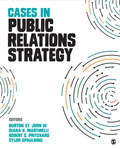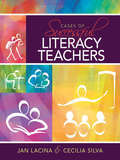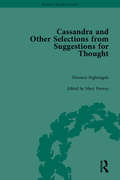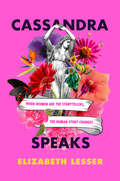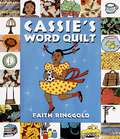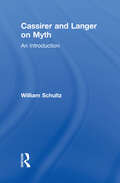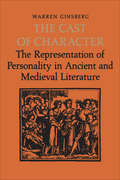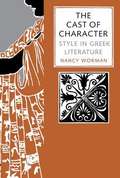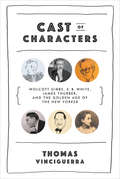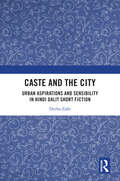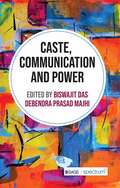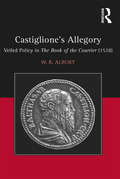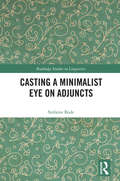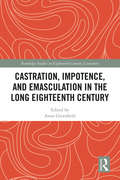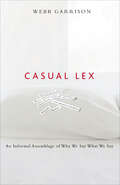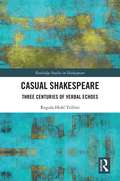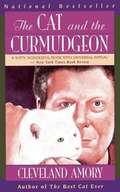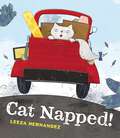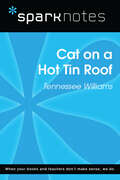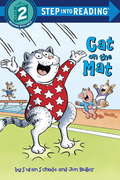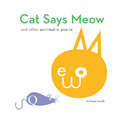- Table View
- List View
Cases in Public Relations Strategy
by Burton St. John Dr Diana Knott Martinelli Mr Robert S. Pritchard Cylor A. SpauldingCases in Public Relations Strategy, by Burton St. John III, Diana K. Martinelli, Robert S. Pritchard, and Cylor Spaulding, draws on original, real-world case studies to provide you with a strategic approach to meeting the needs of a client before, during, and beyond a campaign. Using the RACE (Research, Action Planning, Communication, and Evaluation) model, you will explore successful contemporary campaigns and evaluate best practices in all major areas of public relations activity. This practical, client-oriented text shows you how to systematically evaluate and adapt to the needs of a particular client—whether big or small, global or local, for-profit or nonprofit—in order to launch the most effective campaign. Each case includes a brief introduction focused on fundamentals and core competencies, and all cases have been carefully selected to present a wide range of client types. In addition to the lessons from professionals in the case studies, a section on PR consulting and an appendix on advancing your PR career give you the knowledge and skills you need for success in the field.
Cases of Sherlock Holmes (adapted)
by Arthur Conan Doyle William KottmeyerFour Sherlock Holmes stories are re-told in an adapted version. They are: The Adventure of the Speckled Band, The Red-Headed League, The Adventure of the Six Napoleons, and The Empty House. The adapter explains that the final story is a blend of two of the original Holmes stories. A biography of Holmes is included.
Cases of Successful Literacy Teachers
by Jan Lacina Cecilia S. SilvaHighlighting practices used by exemplary literacy teachers in diverse schools across the nationUsing teaching vignettes, cases for exploration, and research in the field, this text provides preservice and inservice teachers with effective, research-based literacy strategies they can use to improve their practice to best serve students from diverse backgrounds. The cases—based in urban, rural, and suburban settings—help teachers make connections between classroom challenges and the research literature that can help them to become problem solvers and reflective practitioners. Each chapter follows a consistent format in supporting the link between research and practice, and includes the following key features:Focus Questions: Help readers make associations between the chapter text and their prior knowledge and experiencesReading Research to Know: Relates a vignette to research in the field Inside the Classroom: Provides a detailed vignette of teacher instruction in literacy, followed by questions for discussionSummary of Strategies Used: Helps teachers connect the vignette to classroom practiceCase for Exploration: Presents a classroom scenario, along with questions for discussion
Cassandra and Suggestions for Thought by Florence Nightingale (Pickering Women's Classics)
by Florence NightingaleFlorence Nightingale is famous as the heroine of the Crimean War and later as a campaigner for medical care founded on a clean environment and good nursing. Suggestions for Thought, which contains the novel Cassandra, is a central text in nineteenth-century history of feminist thought.
Cassandra Speaks: When Women Are the Storytellers, the Human Story Changes
by Elizabeth LesserWhat story would Eve have told about picking the apple? Why is Pandora blamed for opening the box? And what about the fate of Cassandra who was blessed with knowing the future but cursed so that no one believed her? What if women had been the storytellers? Elizabeth Lesser believes that if women’s voices had been equally heard and respected throughout history, humankind would have followed different hero myths and guiding stories—stories that value caretaking, champion compassion, and elevate communication over vengeance and violence. Cassandra Speaks is about the stories we tell and how those stories become the culture. It’s about the stories we still blindly cling to, and the ones that cling to us: the origin tales, the guiding myths, the religious parables, the literature and films and fairy tales passed down through the centuries about women and men, power and war, sex and love, and the values we live by. Stories written mostly by men with lessons and laws for all of humanity. We have outgrown so many of them, and still they endure. This book is about what happens when women are the storytellers too—when we speak from our authentic voices, when we flex our values, when we become protagonists in the tales we tell about what it means to be human. Lesser has walked two main paths in her life—the spiritual path and the feminist one—paths that sometimes cross but sometimes feel at cross-purposes. Cassandra Speaks is her extraordinary merging of the two. The bestselling author of Broken Open and Marrow, Lesser is a beloved spiritual writer, as well as a leading feminist thinker. In this book she gives equal voice to the cool water of her meditative self and the fire of her feminist self. With her trademark gifts of both humor and insight, she offers a vision that transcends the either/or ideologies on both sides of the gender debate. Brilliantly structured into three distinct parts, Part One explores how history is carried forward through the stories a culture tells and values, and what we can do to balance the scales. Part Two looks at women and power and expands what it means to be courageous, daring, and strong. And Part Three offers “A Toolbox for Inner Strength.” Lesser argues that change in the culture starts with inner change, and that no one—woman or man—is immune to the corrupting influence of power. She provides inner tools to help us be both strong-willed and kind-hearted. Cassandra Speaks is a beautifully balanced synthesis of storytelling, memoir, and cultural observation. Women, men and all people will find themselves in the pages of this book, and will come away strengthened, opened, and ready to work together to create a better world for all people.
Cassie's Word Quilt
by Faith RinggoldThe main character of Coretta Scott King Award and Caldecott Honor winner Tar Beach returns in this imaginative exploration of words, with illustrations that echo artist Faith Ringgold's famous story quilts.Join Cassie, the main character from the picture book Tar Beach, as she takes readers on a tour of her home, neighborhood, and school, introducing dozens of new words and their meaning. Young readers will relish the beautifully designed spreads, each with its own quilt motif.A perfect storytime for kids of all ages, the bright, boldly colored pages will attract even the youngest lookers, while teaching vocabulary and important pre-reading skills to older children.
Cassirer and Langer on Myth: An Introduction (Theorists of Myth #12)
by William SchultzFirst Published in 2000. Routledge is an imprint of Taylor & Francis, an informa company.
Cassirer’s Transformation: From a Transcendental to a Semiotic Philosophy of Forms (Studies in Applied Philosophy, Epistemology and Rational Ethics #55)
by Jean LassègueThis book presents the transformation of Cassirer’s transcendental point of view. At an early stage, Cassirer was confronted with a scientific crisis triggered by the emergence of various forms of objective knowledge, such as the plurality of geometric axiom systems and non-Euclidean geometry in relativistic physics. He finally developed a solution to the problematic unity of objective knowledge by replacing the overarching notion of objectivity with that of forms of objectification. This led him to consider the notion of “symbolic forms” as the driving force in the objectification process. This concept would become instrumental in demonstrating that the objective and human sciences are not adversaries; they merely differ in their modes of semiotic construction. These modes cannot be summarized in a fixed list of symbolic forms but operate transversally, at a level where Cassirer distinguishes between three specific operators: Expression, Evocation and Objectification. The last part of the book investigates how the relationships between these three operators stabilize specific symbolic forms. Four of these forms are then studied as examples: Myth and Ritual, Language, Scientific Knowledge, and Technology.
The Cast of Character: The Representation of Personality in Ancient and Medieval Literature
by Warren GinsbergThis book is concerned with the idea of character and the methods of representing it in ancient and medieval narrative fiction, and shows how late classical and medieval authors adopted techniques and perspectives from rhetoric, philosophy, and sometimes theology to fashion figures who define not only themselves but also their readers. Ginsberg first tests Ovid's concept in the Amores and the Metamorphoses against the conventions of classical tradition and shows how, although Ovid's idea of character did not change, his technique grew more subtle and complex as his art matured. Ginsberg then employs the methods of biblical exegesis to show how medieval characters – Gottfried's Tristan, Dante's Farinata, Chrétien's Yvain – both exist as themselves and point to characters beyond themselves, gaining depth and resonance because we see them in this perspective. Perspective is also a distinguishing quality of the maturing of Boccaccio's art. In the early works his characters seem to be little more than positions in a debate, but as he grew more skilful the strict formalism of binary oppositions gave way to the complexity of experience characteristic of the 'probably true' and culminating in the hundred perspectives of the Decameron. In Chaucer's Canterbury Tales the pilgrims are both typical and individual, twice-formed by the tale and by the frame. A character acts, and the reader forms expectations of his acting and in the process 'character,' the abiding glory of medieval literature, is created.
The Cast of Character: Style in Greek Literature
by Nancy WormanShe demonstrates that, as liars and imitators, pleasing storytellers, and adept users of costume, these two figures are especially skillful manipulators of style. In tracing the way literary representations of them changed through time—from Homer's positive portrayal of their subtle self-presentations to the sharply polarized portrayals of these same subtleties in classical tragedy and oratory—Worman also uncovers a nascent awareness among the Greek writers that style may be used not only to persuade but also to distract and deceive.
Cast of Characters: Wolcott Gibbs, E. B. White, James Thurber, and the Golden Age of The New Yorker
by Thomas VinciguerraThe professional and personal lives of the pioneers of an enduring magazine. From its birth in 1925 to the early days of the Cold War, The New Yorker slowly but surely took hold as the country's most prestigious, entertaining, and informative general-interest periodical. In Cast of Characters, Thomas Vinciguerra paints a portrait of the magazine's cadre of charming, wisecracking, driven, troubled, brilliant writers and editors. He introduces us to Wolcott Gibbs, theater critic, all-around wit, and author of an infamous 1936 parody of Time magazine. We meet the demanding and eccentric founding editor Harold Ross, who would routinely tell his underlings, "I'm firing you because you are not a genius," and who once mailed a pair of his underwear to Walter Winchell, who had accused him of preferring to go bare-bottomed under his slacks. Joining the cast are the mercurial, blind James Thurber, a brilliant cartoonist and wildly inventive fabulist, and the enigmatic E. B. White--an incomparable prose stylist and Ross's favorite son--who married The New Yorker's formidable fiction editor, Katharine Angell. Then there is the dashing St. Clair McKelway, who was married five times and claimed to have no fewer than twelve personalities, but was nonetheless a superb reporter and managing editor alike. Many of these characters became legends in their own right, but Vinciguerra also shows how, as a group, The New Yorker's inner circle brought forth a profound transformation in how life was perceived, interpreted, written about, and published in America. Cast of Characters may be the most revealing--and entertaining--book yet about the unique personalities who built what Ross called not a magazine but a "movement."
Caste and the City: Urban Aspirations and Sensibility in Hindi Dalit Short Fiction
by Deeba ZafirThis book looks at Dalits in the city and examines the nature of Dalit aspirations as well as the making of an urban sensibility through an analysis of hitherto unexamined short stories of some of the first- and second-generation as well as contemporary Dalit writers in Hindi.Tracing the origins of the emergence of Dalit critical consciousness to the arrival of the Dalits into the print medium, after their migration to the city, this book examines their transactions with modernity and the emancipatory promises it held out to them. It highlights the literary tropes that mark their fiction, specifically those short stories which take up urban themes, and shows how even in seemingly caste-neutral spaces caste discrimination is present. The book also undertakes an examination of the stories by contemporary Dalit women writers in Hindi – Rajat Rani Meenu and Anita Bharti – who have posed a radical challenge to both the mainstream feminist movement and the Dalit movement.The volume will be of great interest to scholars and researchers of South Asian literature, especially Hindi literature, Dalit studies, subaltern history, postcolonial studies, political science, and sociology as well as the informed general reader.
Caste, Communication and Power
by Biswajit Das Debendra Prasad MajhiCaste, Communication and Power explores communication and the constitution of caste in Indian society. Intimately connected, both communication and caste are determined by historical developments. The book looks at communication as a lens to study caste and power relations, with its immense potential to shape perception and affect ground reality. It also studies the evolution of the conceptual and theoretical foundations of caste and power relations, and maps their emergence from communicative resources and practices. These communication practices are inevitably linked to the social structure, with their reliance on symbolic forms of self-expression, often revealing the underlying ideological attitudes. The book studies this interface of culture and media, evaluating the caste question and the associated power relations in terms of modes of communication practised in the society.
Castiglione's Allegory: Veiled Policy in The Book of the Courtier (1528)
by W.R. AlburyCastiglione’s Book of the Courtier (Il libro del cortegiano, 1528), a dialogue in which the interlocutors attempt to describe the perfect courtier, was one of the most influential books of the Renaissance. In recent decades a number of postmodern readings of this work have appeared, emphasizing what is often characterized as the playful indeterminacy of the text, and seeking to detect inconsistencies which are interpreted as signs of anxiety or bad faith in its presentation. In contrast to these postmodern readings, the present study conducts an experiment. What understanding does one gain of Castiglione’s book if one attempts an early modern reading? The author approaches The Book of the Courtier as a text in which some of its most important aspects are intentionally concealed and veiled in allegory. W.R. Albury argues that this early modern reading of The Book of the Courtier enables us to recover a serious political message which has a great deal of contemporary relevance and which is lost from sight when the work is approached primarily as a courtly etiquette book, or as a lament for the lost influence of the aristocracy in an age when autocratic nation-states were coming into being, or as an impersonal textual field upon which a free play of transformations and deconstructions may be performed.
Casting a Minimalist Eye on Adjuncts (Routledge Studies in Linguistics)
by Stefanie BodeThis book offers a comprehensive account of adjuncts in generative grammar, seeking to reconcile the differing ways in which they have been treated in the past by proposing a method of analysis grounded in simplification based on Simplest Merge. The volume provides an up-to-date review of the existing literature on adjuncts and outlines their characteristic properties and the subsequent difficulties in adequately defining and treating them. The book compares previous attempts to account for adjuncts which have tended to use additional mechanisms or syntactic operations as a jumping-off point from which to propose a new way forward for analyzing them grounded in minimalist theory. Adopting an approach in the spirit of the strong minimalist thesis (SMT), Bode suggests an analysis of adjuncts which applies a minimalist approach based on theoretical simplicity, one which does not resort to extra mechanisms in capturing the empirical properties of adjuncts. Offering a comprehensive overview of research on adjuncts and foundational minimalist principles, this book will be of particular interest to graduate students and practicing researchers interested in syntax.
Castration, Impotence, and Emasculation in the Long Eighteenth Century (Routledge Studies in Eighteenth-Century Literature)
by Anne Leah GreenfieldThis essay collection examines one of the most fearsome, fascinating, and hotly-discussed topics of the long eighteenth century: masculinity compromised. During this timespan, there was hardly a literary or artistic genre that did not feature unmanning regularly and prominently: from harrowing tales of castrations in medical treatises, to emasculated husbands in stage comedies, to sympathetic and powerful eunuchs in prose fiction, to glorious operatic performances by castrati in Italy, to humorous depictions in caricature and satirical paintings, to fearsome descriptions of Eastern eunuchs in travel narratives, to foolish and impotent old men who became a mainstay in drama. Not only does this unprecedented study of unmanning (in all of its varied forms) illustrate the sheer prevalence of a trope that featured prominently across literary and artistic genres, but it also demonstrates the ways diminished masculinity reflected some of the most strongly-held anxieties, interests, and values of eighteenth-century Britons.
Casual Lex: An Informal Assemblage of Why We Say What We Say
by Webb GarrisonContaining updated editions of the What’s in a Word and Why You Say it, this compendium reveals the history of common words and phrases.Are you a lover of language? Awaken your passion for words, and savor the sheer deliciousness of the things people say!Casual Lex holds the hidden pleasures found in our usage of words. This fresh edition of two etymology classics by Webb Garrison will turn you on to the fascinating—and often surprising—stories behind everyday words and phrases. Experience Casual Lex and discover:The phrase hell on wheels comes from the early American practice of renting railway flatcars to create rolling casinos and brothels bound for the Wild West.Gibberish was the word coined by English villagers to describe the hard-to-understand dialects of certain bands of Gypsies.Gymnasium comes from the Greek word gymnos, which means “naked”—Greek athletes trained and competed in the nude.If your joy of language has been aroused, then many more surprises await you. After all, even the most formal users of our language can benefit from a little Casual Lex“A rather good book to have at hand.” —Kirkus Reviews on Why You Say It
Casual Shakespeare: Three Centuries of Verbal Echoes (Routledge Studies in Shakespeare)
by Regula Hohl TrilliniCasual Shakespeare is the first full-length study of the thousands of quotations both in and of Shakespeare's works which represent intertextuality outside of what is conventionally appreciated as literary value. Drawing on the insights gained as a result of a major, ongoing Digital Humanities project, this study posits a historical continuum of casual quotation which informs Shakespeare's own works as well as their afterlives. In this groudbreaking, rigorous analysis, Dr. Regula Trillini offers readers a new approach and understanding of the use and impact quotes like the infamous, 'To be or not to be,' have had througout literary history.
The Cat and the Curmudgeon
by Cleveland AmoryThe Runaway Sequel to the Runaway Bestseller about the Runaway Cat Famous fabulist and curmudgeon humorist Cleveland Amory has done it again. In this best-selling sequel to The Cat Who Came for Christmas, Amory and feisty feline Polar Bear continue their wonderful true adventures. Despite his hard-knock beginnings, Polar Bear is finicky about his newfound fame. Will he overcome his aversion to the paparazzi? Will nine lives be long enough for him to answer all his fan mail? Will Cleveland's story of Nancy Reagan's family furniture finally lure Polar Bear from beneath the bed? This tale of two curmudgeons will tickle the fancy of everyone who has ever been owned by a cat.
Cat in a Cap
by Mia Hirsh Cindy Peattie Joan CzernichowskaTitle contained within StartUp Phonic Core Program. Not Sold Separately
Cat Napped
by Leeza HernandezMosey cat. Nosey cat.Curl up nice and cozy cat. Cats are naturally curious, but sometimes too much curiosity can get them into trouble! That’s what happens when one kitty wakes up from a nap to find she might be lost . . .Luckily, a kind passerby and the folks at the animal shelter are ready to help reunite her with her favorite friend!
Cat on a Hot Tin Roof (SparkNotes Literature Guide Series)
by SparkNotesCat on a Hot Tin Roof (SparkNotes Literature Guide) by Tennessee Williams Making the reading experience fun! Created by Harvard students for students everywhere, SparkNotes is a new breed of study guide: smarter, better, faster.Geared to what today's students need to know, SparkNotes provides:*chapter-by-chapter analysis *explanations of key themes, motifs, and symbols *a review quiz and essay topicsLively and accessible, these guides are perfect for late-night studying and writing papers.
Cat on the Mat
by Susan Schade Jon BullerGolden Books' dynamic series is the Only complete literacy program on the market. This program offers books at five levels, or Miles, that accompany children from their first attempts at reading and writing to successfully reading and writing on their own. -- Mirrors current teaching methods-- Fiction and nonfiction-- High-interest stories and kid-picked topics
Cat Says Meow: And Other Animalopoeia
by Michael ArndtDog says woof . . . pig says oink . . . cow says moo. Animals and the sounds they make are paired up in playfully compelling ways in this eye-catching illustrated gift book featuring bold colors and an engaging use of onomatopoeia. Kids and parents will delight in discovering the ways in which the letters that spell out each animal's sound are key elements of that animal's illustration. With so much to see and to sound out, kids will relish this unique visual and educational experience, brimming with color and letters. Plus, this is a fixed-format version of the book, which looks nearly identical to the print version.
